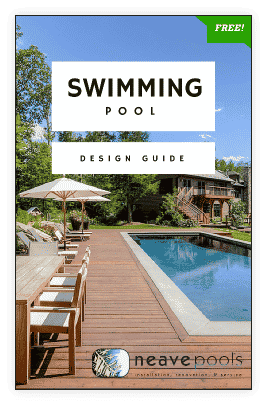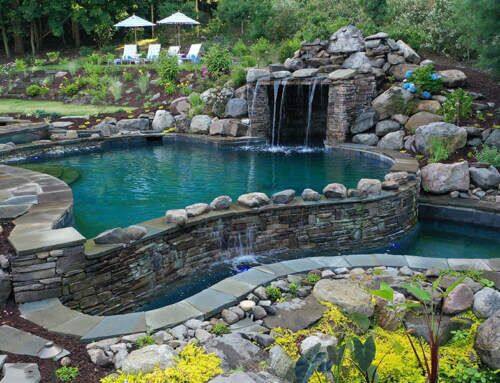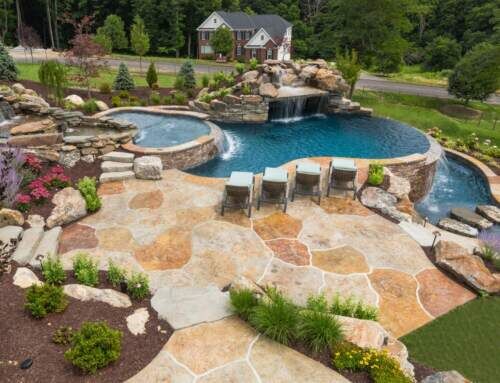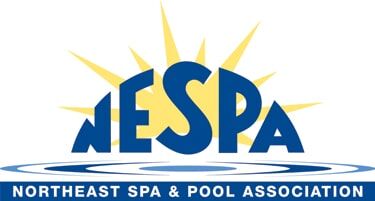Pool sanitization is one of the most important things that happen in your pool — it keeps the water clear and prevents the transmission of infectious diseases. But sorting out your pool sanitizer options can be confusing.
Here at Neave Pools, we get a lot of customer questions about the options. And we hear the same misconception over and over: people say they hate chlorine.
Commercial pools typically keep chlorine at high levels, causing burning eyes and faded swimsuits, so chlorine has a pretty bad reputation.
But don’t blame chlorine as a product. It does a fine job sanitizing your pool. Where the problem comes in is human error — pool owners putting too much of it in their pool.
The pool industry has determined the amount of chlorine needed to kill bacteria and algae is 1 to 3 parts per million.
A Closer Look At 7 Pool Cleaning Systems
At those levels, you hardly notice chlorine. But because of chlorine’s bad reputation, an industry sprang up to offer pool sanitation systems that use less chlorine.
Note we said “less” chlorine. These alternative pool systems don’t eliminate it completely. Let’s take a look at the different pool cleaning systems available to sanitize your pool.
Salt Chlorine Generator
The salt chlorine generator is currently the number one pool cleaning system and the one the experts at Neave Pools recommend. It has revolutionized swimming pool care. A salt chlorinator uses common table salt to produce all the chlorine a pool needs, safely, effectively, and automatically.
This system is like cruise control for your pool. It keeps a low, even, safe level of chlorine all the time — without the drawbacks of manually adding chlorine.
No chlorine tablets, liquid or granules to add, so it reduces that problem we mentioned earlier of human error. That means less skin and eye irritation than in traditionally-chlorinated swimming pools.
Another advantage: it eliminates the problems caused by the inert materials in chlorine pool tablets.
If you’ve ever read the ingredients on your chlorine tablets, you noticed it said they’re 45 percent chlorine and 55 percent “inert materials.”
Those inert ingredients mess with other variables in your pool. For one thing, they lower the pH in your water. Did you ever notice in the pool supply aisle how pH decreaser is sold in little tubs, but pH increaser is sold in giant 20 lb. containers?
Salt-generated chlorine produces nearly neutral pH levels, so few additional chemicals are required to balance your pool’s pH levels.
The cost for this system is about $2,000. You replace the salt cell every 5 to 7 years, at a cost of several hundred dollars.
Buying a salt chlorine generator might take five years to pay for itself, compared to buying and adding your own chlorine, but the lifestyle benefits are immediate. Your pool water is always clean, and there’s no green water when you get back from vacation.
Chlorine Feeders
Inexpensive and easily available, chlorine is the chemical most commonly used in swimming pools and hot tubs to kill bacteria that can spread disease.
With the feeder method, you fill the chlorine feeder with chlorine tablets or sticks, select a setting on the dial and the chlorine is released into the pool. When it’s empty, you refill it.
The idea is to maintain a consistent feed of chlorine into the pool. But if the feeder malfunctions, isn’t filled or isn’t set properly, then the chlorine level will be off and the pool won’t be fit for swimming.
Ozone
Pool ozone gas is generated by combining oxygen with electricity using an ozone generator. It’s added to pool water after it goes through the filter and heater.
This helps control the water clarity and appearance and gets organisms out of the pool. It doesn’t sanitize and kill bacteria, so you still need to add a low level of chlorine.
Ozone has no effect on the pH levels of swimming pools, which means less pH adjustment.
It’s more expensive than chlorine and there’s a storage disadvantage: ozone has a short half-life, which means it can’t be stored. You have to use it soon after it’s produced.
UV Pool
In the ultraviolet method, pool water circulates through a chamber that destroys or inactivates microorganisms by exposing them to ultraviolet light. The system reduces the need for chlorine and other chemical sanitizers.
UV light sanitization will kill bacteria and algae, but it doesn’t work as an oxidizer for the water, so you still need to add a low level of chlorine or add an oxygenator to the UV system.
Ionizer
An ionizer uses a low electric current to create copper and silver ions that attract and kill algae, bacteria and viruses.
Copper is a great algaecide, and this method is very effective. But to do it properly takes a science degree. Also, the metal ions released by ionizers are slow-acting and take several hours to start fighting contaminants.
And although they reduce the need for many chemicals, ionizers can’t sufficiently sanitize swimming pool water alone. Some amounts of chlorine are still needed.
Alternative Chemicals
While chlorine is the most popular, it isn’t the only pool chemical sanitizer out there. Bromine is similar to chlorine in terms of sanitizing, but its smell is less pungent. It also sanitizes for a longer time than chlorine.
However, it’s less stable than chlorine, so in an outdoor pool, it will degrade from the sun’s UV rays. That makes it an expensive proposition for an outdoor pool because it has to be added often. It’s a better bet for indoor pools or covered spas. It’s also more expensive than both chlorine and salt.
Biguanide is another chemical option. It’s been used for decades in the medical community, in gauze dressings and contact lens solutions to prevent infections. Biguanide attracts bacteria to it, and then penetrates the germs’ cell wall, killing the bacteria.
Pool owners need to check the residual level of biguanide weekly, using a special test kit, and add more of the product when it drops below a certain level. They also must monitor pH levels and add an algaecide weekly or biweekly and shock with hydrogen peroxide monthly.
One thing to note: chlorine and biguanide are incompatible and can’t be mixed. So if you switch, you have to switch 100 percent.
Bio Pool
The ultimate in green pool sanitation methods, using a bio pool is the only truly chlorine-free pool. How it works is pretty fascinating.
You build a smaller pool next to your swimming pool, like a shallow pond. Water is piped from the swimming pool to the pond, which overflows and spills back into the pool. Meanwhile, rocks and plant life in the pond treat the water — it gets oxygen as it runs over rocks.
You don’t add anything.
There are only a few of these systems in the United States, but they’re more widely accepted in Europe and Australia. They’re still very new here and very expensive to build. But they cost nothing to operate.
Trust Neave With Your Pool Cleaning System
Neave Pools has certified pool operators on staff who are trained in proper pool sanitizing techniques. We’ll advise you on pool maintenance and how to best keep your pool water clean, safe and sparkling.
We offer several chlorine and chemical alternatives for pool sanitizing.
Neave Pools can develop a schedule based on what you need so that one of our certified professionals can become your personal pool chemist during the summer months, ensuring your pool water is of the highest quality.
If you’re in Hudson Valley, call (845) 463-0592. Westchester, call (914) 271-7996. Cold Spring, call (845) 463-0592, and in Connecticut, call (203) 212-4800. Or fill out the handy web form on this page, and we’ll get in touch with you to schedule a complimentary swimming pool consultation.


























